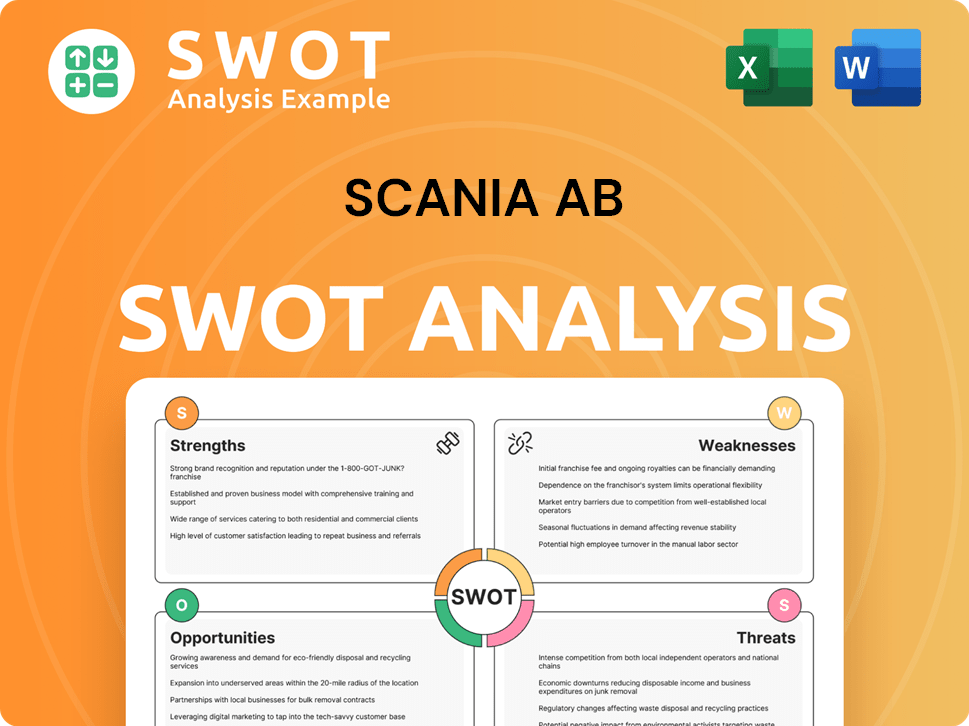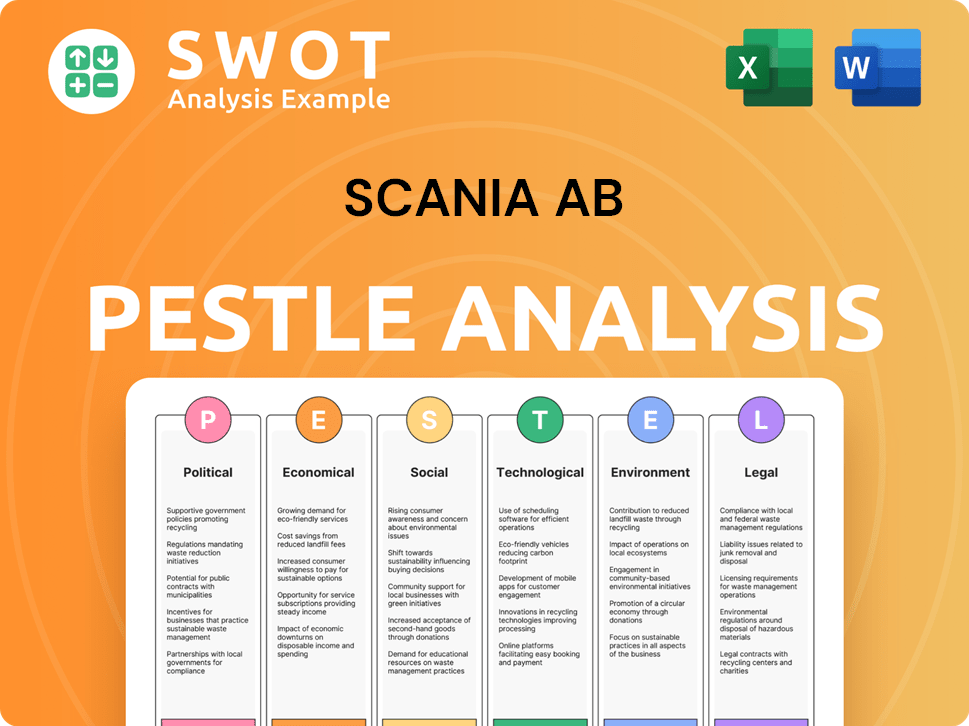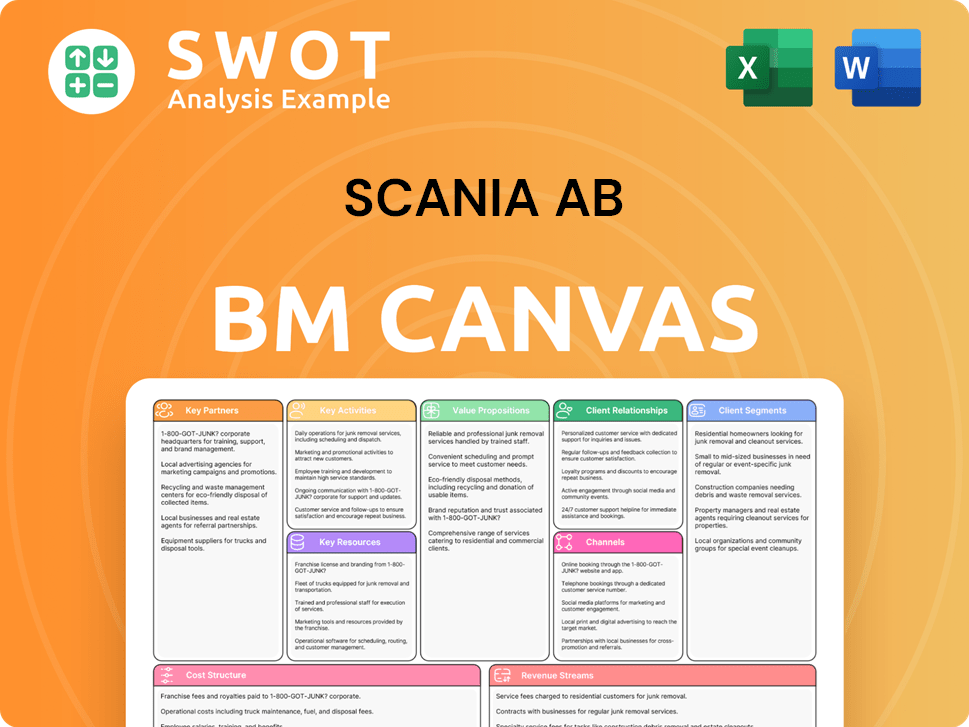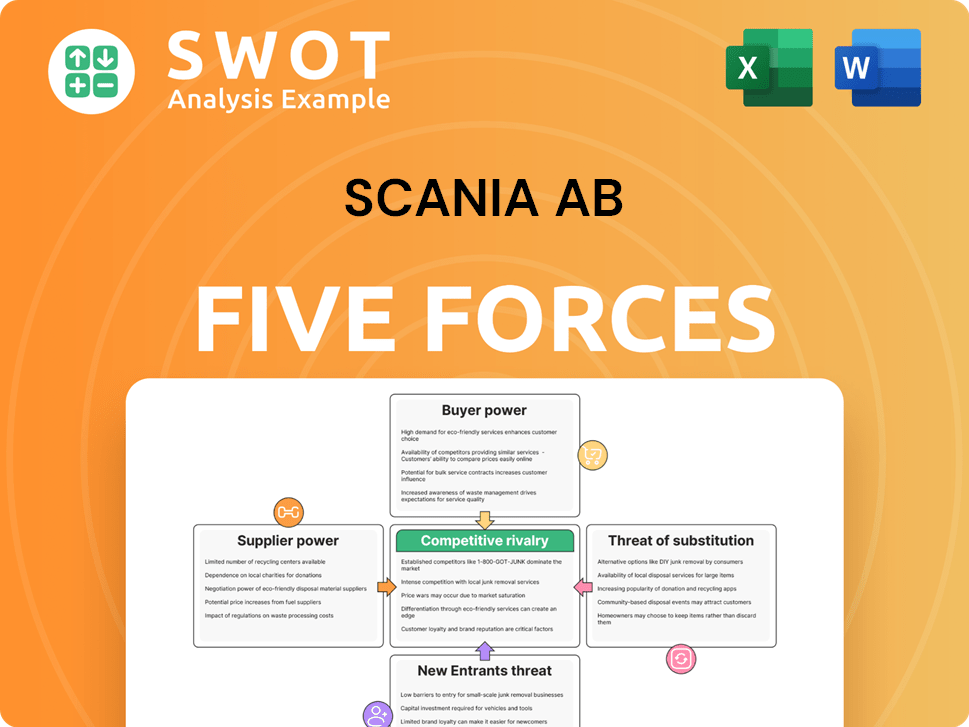Scania AB Bundle
Can Scania AB Maintain Its Edge in a Shifting Truck Market?
Scania AB, a titan of the heavy vehicle industry, is facing a rapidly changing competitive environment. From its humble beginnings in Sweden to its current global presence, Scania has consistently delivered robust transport solutions. But with the truck industry undergoing massive technological and environmental shifts, how is Scania AB navigating this new landscape?

This analysis of the Scania AB SWOT Analysis will explore Scania's position within the truck industry, examining its market share, key competitors, and competitive advantages. We'll delve into the factors shaping the future of heavy-duty vehicles, including sustainability initiatives, electric truck competition, and strategies for market dominance. Understanding the Scania AB competitive landscape is crucial for anyone looking to make informed decisions in this dynamic commercial vehicles sector.
Where Does Scania AB’ Stand in the Current Market?
Scania AB, a prominent player in the global commercial vehicle market, focuses on heavy trucks, buses, and power solutions. The company's core operations involve the design, manufacturing, and sale of these vehicles, along with related services like financial solutions and service contracts. Scania's value proposition centers on providing high-quality, reliable, and sustainable transport solutions to its customers, supported by a strong global service network.
In 2024, Scania demonstrated robust financial performance, with net sales reaching SEK 216.1 billion and an adjusted operating income of SEK 30.4 billion. The company's commitment to innovation and sustainability is evident in its strategic shift towards electric vehicles, aiming for 50% of sales to be electric by 2030. This focus on sustainable transport solutions positions Scania well for future market trends, as highlighted in the Marketing Strategy of Scania AB.
Scania's global presence is marked by strong market shares in key regions, including Europe and Latin America. The company's 'Super driveline' technology has contributed to increased profitability and market share, even amidst economic challenges. Despite a slight decrease in sales revenue in Q1 2025, the company's incoming orders increased, indicating continued demand and a positive outlook.
Scania's European truck market share grew by over 2% to 17.8% in 2024, demonstrating strong market position. In Latin America, the market share increased to 17.3%, with particularly strong demand in Brazil. The company is focused on maintaining and expanding its market presence through product innovation and strategic initiatives.
Scania's primary product lines include heavy trucks, buses, and power solutions, catering to diverse customer needs. Revenue from the service business increased by 3% in 2024 and 4% in Q1 2025, providing ongoing stability. The company also offers financial services and service contracts, enhancing customer relationships and revenue streams.
Scania is actively shifting towards sustainable transport solutions, with a strong focus on electrification and battery-electric vehicles. While zero-emission vehicle (ZEV) deliveries amounted to 266 units in 2024, the company aims for 50% of its vehicle sales to be electric by 2030. This strategic direction positions Scania well in the evolving market.
In 2024, Scania's net sales reached SEK 216.1 billion, and adjusted operating income was SEK 30.4 billion. Despite a decline in sales revenue in Q1 2025, incoming orders increased by 23%, indicating continued demand. These figures reflect Scania's strong financial health and resilience in the competitive market.
The Scania AB competitive landscape includes major players in the truck industry, such as Volvo Trucks, Daimler Truck, and MAN Truck & Bus. Scania's competitive advantages stem from its strong brand reputation, focus on premium quality, and commitment to sustainability. The company's global presence and comprehensive service network further strengthen its market position.
- Market Share: Scania's market share in Europe and Latin America is a key indicator of its competitive strength, with continued growth in these regions.
- Product Innovation: The 'Super driveline' technology and the shift towards electric vehicles highlight Scania's focus on innovation.
- Financial Performance: The company's financial results, including net sales and operating income, reflect its overall health and ability to compete effectively.
- Sustainability: Scania's sustainability initiatives, particularly its electric vehicle strategy, are crucial for long-term competitiveness.
Scania AB SWOT Analysis
- Complete SWOT Breakdown
- Fully Customizable
- Editable in Excel & Word
- Professional Formatting
- Investor-Ready Format

Who Are the Main Competitors Challenging Scania AB?
The competitive landscape for Scania AB is intense, shaped by a global market for commercial vehicles. The company faces strong competition from established players and emerging challengers. Understanding this landscape is crucial for evaluating Scania's market position and future prospects. A thorough Brief History of Scania AB provides context for analyzing its competitive dynamics.
Scania's key competitors include major players in the truck industry, each vying for market share and technological leadership. These rivals challenge Scania across various dimensions, from product innovation to global distribution. The competitive environment is further complicated by mergers, acquisitions, and the emergence of new technologies, such as electric and autonomous vehicles.
The commercial vehicle market is dynamic, with companies constantly adapting to changing customer demands and technological advancements. This creates a complex competitive environment where strategic decisions and adaptability are critical for success. Analyzing the strategies of Scania's competitors provides insights into the broader trends shaping the truck industry.
AB Volvo is a primary competitor of Scania, particularly in the heavy truck and bus segments. Both companies are known for their premium offerings and global presence. The competition between them is often fierce, especially in the European market, where they both hold significant market shares.
Daimler Truck Holding AG, with brands like Mercedes-Benz, Freightliner, and Fuso, presents a formidable challenge to Scania. Daimler boasts a wide product portfolio and strong global distribution networks. This extensive reach allows Daimler to compete effectively across various geographical markets and customer segments.
MAN Truck & Bus SE, part of the TRATON Group alongside Scania, also acts as a direct competitor. Despite being within the same group, MAN's performance, such as a decline in truck sales in 2024, highlights the competitive dynamics within the TRATON Group. This internal competition drives innovation and market focus.
PACCAR Inc. is another significant competitor, particularly in North America and other key markets. PACCAR's brands, such as Kenworth and Peterbilt, are well-established and known for their quality and reliability. They compete with Scania in the premium segment of the truck industry.
Iveco Group NV competes with Scania in various segments of the commercial vehicle market. Iveco's product range and global presence make it a notable player. The company focuses on innovation and sustainability to stay competitive in the evolving industry.
Mitsubishi Fuso Truck and Bus Corporation competes in specific segments, particularly in Asia and other international markets. The company's focus on efficiency and technological advancements helps it maintain a competitive edge. It's a player in the global commercial vehicle market.
Several factors drive competition in the commercial vehicle market, influencing Scania's strategic decisions and market performance. These factors include technological innovation, pricing strategies, and distribution networks. The evolution of these factors shapes the competitive landscape.
- Electric and Autonomous Vehicle Technologies: Rivals are investing heavily in electric and autonomous vehicle technologies. For example, Scania is scaling up battery-electric truck production.
- Price and Branding: Competitive pricing and strong branding are essential for attracting customers. Scania's premium brand positioning is a key differentiator.
- Distribution Networks: Extensive and efficient distribution networks are crucial for market reach. Competitors with strong global networks have a significant advantage.
- Fuel Efficiency and Digital Solutions: Technological advancements in fuel efficiency and digital solutions are critical. These innovations improve operational efficiency and reduce costs for customers.
Scania AB PESTLE Analysis
- Covers All 6 PESTLE Categories
- No Research Needed – Save Hours of Work
- Built by Experts, Trusted by Consultants
- Instant Download, Ready to Use
- 100% Editable, Fully Customizable

What Gives Scania AB a Competitive Edge Over Its Rivals?
The competitive landscape for Scania AB is shaped by its robust competitive advantages, which include a modular system developed over decades. This system allows for flexible, customer-focused solutions and efficient production, enhancing its versatility in the truck industry. Proprietary technologies like the 'Super driveline' and 'Scania Opticruise' gearbox contribute to exceptional fuel efficiency and performance, making Scania a strong player in the heavy-duty vehicles market.
Scania's brand equity and customer loyalty are significant assets, built on a reputation for quality and reliability. Its largely captive service network provides direct customer contact, which helps in understanding specific market needs. The company is also focusing on sustainable transport solutions, including investments in green electricity and decarbonized logistics, which aligns with evolving customer preferences and regulatory requirements. This focus is a key element in the Scania market analysis.
Strategic investments in research and development, particularly in electrification and digital solutions, are critical for maintaining its competitive edge. Scania is expanding its supplier network to enhance resilience and accelerate deliveries of its premium battery-electric trucks, for which demand is rising rapidly. Furthermore, Scania's collaboration with OpenAI to implement ChatGPT Enterprise aims to boost productivity and enhance driver experience through AI technology vehicle integrations.
Scania's modular system allows for highly customized vehicle solutions. This approach enables efficient production and caters to diverse customer needs within the commercial vehicles sector. The flexibility in design and production is a significant advantage in a competitive market.
The 'Super driveline' and 'Scania Opticruise' gearbox enhance fuel efficiency and performance. The Scania Super 11 engine provides up to 7% better fuel efficiency, which is crucial for reducing operational costs. These technological advancements are key in the Owners & Shareholders of Scania AB competitive landscape.
Scania's strong brand equity is built on a reputation for quality and reliability. This reputation fosters customer loyalty and supports premium pricing strategies. The company's service network further strengthens customer relationships.
Investments in sustainable transport solutions enhance brand image and align with customer preferences. Scania's focus on decarbonized logistics and lower energy use positions it well in the evolving market. These initiatives are vital for long-term competitiveness.
Scania AB's competitive advantages are multifaceted, ranging from its modular production system to its commitment to sustainability. These strengths are crucial for navigating the challenges in the truck industry. The company's strategic focus on technology and customer relationships supports its market position.
- Modular System: Enables customization and efficient production.
- Technological Leadership: Drives fuel efficiency and performance.
- Strong Brand: Builds customer loyalty and supports premium pricing.
- Sustainability: Enhances brand image and meets regulatory demands.
Scania AB Business Model Canvas
- Complete 9-Block Business Model Canvas
- Effortlessly Communicate Your Business Strategy
- Investor-Ready BMC Format
- 100% Editable and Customizable
- Clear and Structured Layout

What Industry Trends Are Reshaping Scania AB’s Competitive Landscape?
The commercial vehicle sector is experiencing a substantial transformation, largely influenced by the push for more sustainable transport solutions and technological advancements. This transition presents both significant challenges and opportunities for companies like Scania. Understanding the Scania AB competitive landscape is crucial for investors and stakeholders looking to navigate the evolving market dynamics.
The shift towards electric and autonomous vehicles is accelerating, driven by stricter emission regulations and rising fuel costs. This trend has a direct impact on Scania market analysis, necessitating strategic adaptations in product development, supply chain management, and market positioning. A deep dive into Scania competitors is essential to understand how the company is positioning itself within this dynamic environment.
The truck industry is seeing a surge in demand for electric trucks, with a projected CAGR of about 27% from 2024 to 2030. This growth is fueled by environmental concerns and government regulations. Advancements in battery technology and digital solutions are also reshaping the competitive landscape, with companies investing heavily in these areas.
Scaling up battery-electric truck production presents complexities, impacting decarbonization efforts. Global supply chain disruptions, due to geopolitical tensions, can hinder production. Although demand for electric vehicles is growing, only 2% of new trucks sold in the EU are zero-emission, indicating infrastructure and policy support are needed.
The electric truck market, expected to exceed $200 billion in the next decade, offers immense growth potential. Battery-electric and clean fuel options create opportunities in urban and intercity transport. Strategic partnerships, such as those with DHL Group and Cometto, are vital for capturing these opportunities.
Scania is focusing on sustainability and innovation, with ambitious 2032 emission reduction targets. Prioritizing partnerships for eco-friendly technologies, enhancing supply chain flexibility, and leveraging technology for operational efficiencies are key strategies. For a detailed look at how Scania generates revenue, check out the Revenue Streams & Business Model of Scania AB.
To maintain its competitive edge, Scania is focusing on several strategic initiatives. These include expanding its battery-electric truck production and developing new software platforms, with active investments in cutting-edge technologies.
- Partnerships: Collaborations with companies like DHL Group and Cometto are critical for expanding into new markets and technologies.
- Sustainability Targets: Setting and achieving ambitious emission reduction goals, such as a 50% cut in operational emissions by 2032.
- Technological Advancements: Investing in AI integration and software platforms to improve operational efficiency and customer service.
- Market Expansion: Focusing on electric and hybrid power solutions for construction and mining, alongside urban transport options.
Scania AB Porter's Five Forces Analysis
- Covers All 5 Competitive Forces in Detail
- Structured for Consultants, Students, and Founders
- 100% Editable in Microsoft Word & Excel
- Instant Digital Download – Use Immediately
- Compatible with Mac & PC – Fully Unlocked

Related Blogs
- What are Mission Vision & Core Values of Scania AB Company?
- What is Growth Strategy and Future Prospects of Scania AB Company?
- How Does Scania AB Company Work?
- What is Sales and Marketing Strategy of Scania AB Company?
- What is Brief History of Scania AB Company?
- Who Owns Scania AB Company?
- What is Customer Demographics and Target Market of Scania AB Company?
Disclaimer
All information, articles, and product details provided on this website are for general informational and educational purposes only. We do not claim any ownership over, nor do we intend to infringe upon, any trademarks, copyrights, logos, brand names, or other intellectual property mentioned or depicted on this site. Such intellectual property remains the property of its respective owners, and any references here are made solely for identification or informational purposes, without implying any affiliation, endorsement, or partnership.
We make no representations or warranties, express or implied, regarding the accuracy, completeness, or suitability of any content or products presented. Nothing on this website should be construed as legal, tax, investment, financial, medical, or other professional advice. In addition, no part of this site—including articles or product references—constitutes a solicitation, recommendation, endorsement, advertisement, or offer to buy or sell any securities, franchises, or other financial instruments, particularly in jurisdictions where such activity would be unlawful.
All content is of a general nature and may not address the specific circumstances of any individual or entity. It is not a substitute for professional advice or services. Any actions you take based on the information provided here are strictly at your own risk. You accept full responsibility for any decisions or outcomes arising from your use of this website and agree to release us from any liability in connection with your use of, or reliance upon, the content or products found herein.